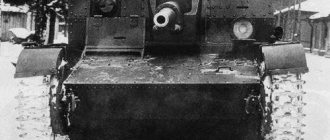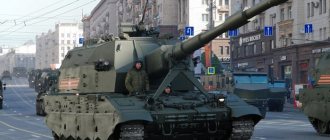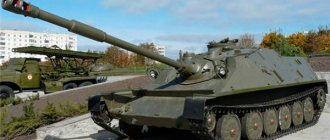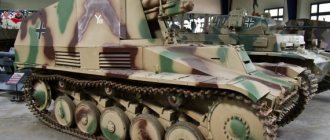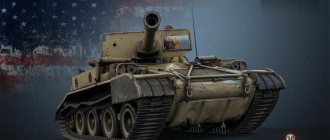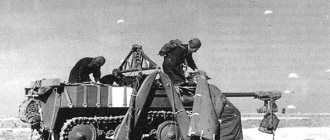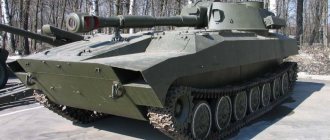The world's only self-propelled gun SU-26 has been recreated
On the eve of the most important date in the history of the Great Patriotic War - the complete lifting of the blockade of Leningrad - a unique find. This is a SU-26 self-propelled artillery mount. Then, at the beginning of the war, a regimental gun from the 1920s was installed on the surviving chassis of the T-26 light tank. It turned out to be such a self-propelled gun.
Place for the driver, frontal protection for the rotating wheelhouse. And there is no one behind her. You can even see where the loader and shooter are sitting. In besieged Leningrad, no more than three dozen of these were made. And all of them were considered lost until recently. But one copy was nevertheless found and restored.
In all military archives it is like a ghost car. There are almost no photographs, no technical documentation has been preserved. But today the SU-26 self-propelled artillery unit woke up after almost 80 years of sleep. Only 29 of these vehicles were assembled for the defense of Leningrad. All of them were destroyed in fierce battles. But only one artillery installation, this SU-26, was found and restored from the wreckage.
The SU-26 was created from destroyed tanks in besieged Leningrad under difficult conditions. Workers at the Kirov plant installed regimental guns of the 1927 model on the chassis of T-26 tanks, covered them with armored sheets, and the result was a cramped turret.
“In the cramped space of this cabin there were two crew members, two crew members. To aim the gun, the armored shields were opened, and through the sight the gunner could aim the gun,” says deputy director of the museum Vasily Zabolotny.
Cannon, two machine guns, large ammunition. SU-26 supported the infantry and took part in the most fierce battles. Search engines stumbled upon this car three years ago in the swamps near St. Petersburg. Until today, restoration work has been carried out. This is a long journey - from rusty wreckage to a fully operational artillery mount on the move. In those places where the armor is uneven and corroded, original parts are installed. Thanks to working with archives around the world, it was even possible to find and return her original number, which was printed on her armor.
“The 122nd Red Banner Tank Brigade, which took part in the battles on the Leningrad Front, at Pogostye station is a railway station where heavy fighting took place. The Red Army tried to break through the siege of Leningrad from the outside,” said Alexander Zaitsev, head of the museum’s historical department.
Today, the only SU-26 in the world has taken a place in the Museum of Russian Military History in the village of Padikovo near Moscow. Anyone can visit its exhibitions free of charge. The history of besieged Leningrad is treated with particular reverence here and many other unique exhibits have been collected.
“Here is a very interesting invention of Leningrad engineers - a bottle launcher of the Tsukerman system. An attachment was made to the rifle, and a Molotov cocktail was inserted into it. It was fired with an ordinary blank rifle cartridge at a distance of 150-200 meters,” said Dmitry Persheev, director of the Museum of Russian Military History.
The exhibitions of this museum occupy several buildings and tell about the tragic and heroic moments of our military history.
“This is not a museum of technology, not a museum of weapons. Despite the fact that our museum has a fairly large number of tanks, guns, exhibits, and posters, it’s all here to tell people about the history of the Great Patriotic War and the military history of our country in general, so that they can learn how it really happened,” said museum manager Natalya Yarygina.
The installation of the SU-26 is also, first of all, our history, the history of the people, the crew who died in it during the battle. But their goal was achieved - Leningrad survived.
Gallery[edit]
- SU-26 in the process of production.
- SU-26 during production at the Kirov plant, October 1941.
- SU-26 in battles near Leningrad, winter 1942.
- SU-26 destroyed February 20, 1942
- Light Soviet self-propelled gun SU-26 in a position near the House of Soviets in Leningrad.
- SU-26 projections.
- SU-26 equipped with a 76.2 mm regimental gun, winter 1941 - 1942.
Content
- 1 History of creation
- 2 Use and further development
- 3 Design description 3.1 Chassis
- 3.2 Engine
- 3.3 Transmission
- 3.4 Tower
- 3.5 Cannon
- 3.6 Communications.
- 6.1 In the computer and gaming industry
Background
As mentioned above, the Soviet army suffered huge losses. First of all, due to the lack of equipment capable of quickly moving from one place to another and destroying enemy tanks while supporting infantry. Conventional guns were poorly suited for such a task, since the five-man artillery crew could only turn the gun, but not carry it over long distances. Of course, a standard regimental gun could penetrate the armor of the first models of the famous “Tiger” or “Panther” with the first shot, but a completely different type of equipment was required - something like a “gun on a tank chassis” so that it could keep up with the infantry, maneuver and withstand the blow.
You may be interested in: The meaning of the word “toil”, or a play of imagination
The fact is that German tanks could crush or destroy a conventional cannon with an aimed shot, since it simply stood still, and the difference in distance to which the crew could move it was insignificant for the German tank crews.
An armor-protected gun on a tracked chassis radically changed the situation. Now it was much more difficult for the enemy to both hit a moving cannon and destroy it the first time with a shell.
Optional equipment
As with any artillery at any level, we have little choice. “Reinforced aiming drives” and “Medium caliber howitzer rammer” are mandatory for us - improved aiming and fast reloading have never hurt anyone. In place of the third equipment, you can install a “Camouflage Network” or a “Stereo Tube” - whichever you prefer. “Network” will be a very good choice for us, since we have a turret and can conduct aimed fire without turning the hull, without canceling the camouflage bonus. Stereo tube is also a good option. Although our visibility is only 320m, it’s worth considering that at level 3 everyone’s visibility is low, and 80m of additional “big eyes” can sometimes take the situation from the endgame to a victorious result. Our prices for equipment are as follows:
- “Reinforced aiming drives” - 500,000 silver
- “Medium caliber howitzer rammer” – 300,000 silver
- “Camouflage net” – 100,000 silver
- “Stereotube” – 500,000 silver
Surviving copies[edit | edit code]
At the beginning of 2022, the reconstructed SU-26 was presented to the public, restored by enthusiasts based on original parts found at battle sites, as well as newly manufactured elements. Exhibited at the Museum of Russian Military History (village Padikovo, Istra district, Moscow region)[6].
Tactics
Our main tactical advantage is the presence of a turret that rotates 360 degrees. Thanks to it, we can conduct targeted fire at moving targets, while minimizing the chances of detection. Due to the specific nature of pre-top guns, we will be forced to change position frequently, because the firing range of these guns is not very good. The top weapon will cover almost the entire map, but you will still have to move. Considering our small dimensions, the SU-26 can hide behind any bush and remain unnoticed. As with any other self-propelled guns, it is important for us to remember that at the first danger we must change position. Don't neglect this. Remember - destroyed equipment cannot fire. Therefore, it is better to start the engine once again and take a short ride with the breeze to a secluded place, rather than hoping to fire a couple of shots at the approaching enemy and die.
Regarding which shells are best to fill our ammunition load: take equal parts armor-piercing and landmines. It’s not worth taking cumulative shells, since they are no better than armor-piercing shells and don’t pay for themselves - so you’ll simply throw away money.
Follow these rules and most fights will be victorious for you.
Engine
The motor from the original T-26 was used as the driving force for the self-propelled gun, which was replaced a year later with the more advanced T-26F. An interesting fact was that both engines were copied from the English Armstrong-Sidley engine. It was heavy, bulky and had a power of only 91 hp. With. Even the installation of a forced version of the engine did not change the situation. This did not add power to the engine, but the weight of the overall structure of the self-propelled gun increased significantly, which negatively affected its already low maneuverability.
Usage
The tank-building concern managed to produce a considerable number of vehicles by the end of 1941. And they were all immediately sent to the front after short preliminary tests. Of course, not all military units had enough self-propelled guns. But those brigades that were in the first echelon of the front received four vehicles each. These were mainly divisions holding the defense in different sectors of the Leningrad Front.
After all the produced vehicles were again in the repair shops of the plant, they, like the T-26 tank at one time, themselves became spare parts and consumables. By that time, the government had already realized the ineffectiveness of this type of equipment and instructed members of the design bureau to develop a radically new type of self-propelled vehicle.
Creation
Having realized that experiments on combining a regimental gun and a tracked chassis from different weight categories were hardly worth continuing, the commission of the plant’s design bureau decided to develop a separate self-propelled unit, the main task of which would be fast but short-term direct support for infantry, as well as the destruction of enemy light and medium vehicles .
You may be interested in: Teaching history at school: teaching methods, types and forms of lessons
In August 1941, two months after the start of the war, the world-famous Lifting and Transport Facilities Plant named after. Kirov in the city on the Neva presented a project for a self-propelled gun SU-26, which later received a slightly different designation - SU-76. The vehicle was created on the basis of a domestically produced light tank. The designers nevertheless decided to give the T-26 another chance, but this time they did not just insert a cannon into the vehicle’s turret, but completely removed all combat equipment from the vehicle, leaving only the chassis and upper frontal armor plates. The side protective sheets were changed to thicker ones. The cabin acquired a more elongated rectangular shape, and its front side became a kind of shield, like the shield of a field artillery gun.
